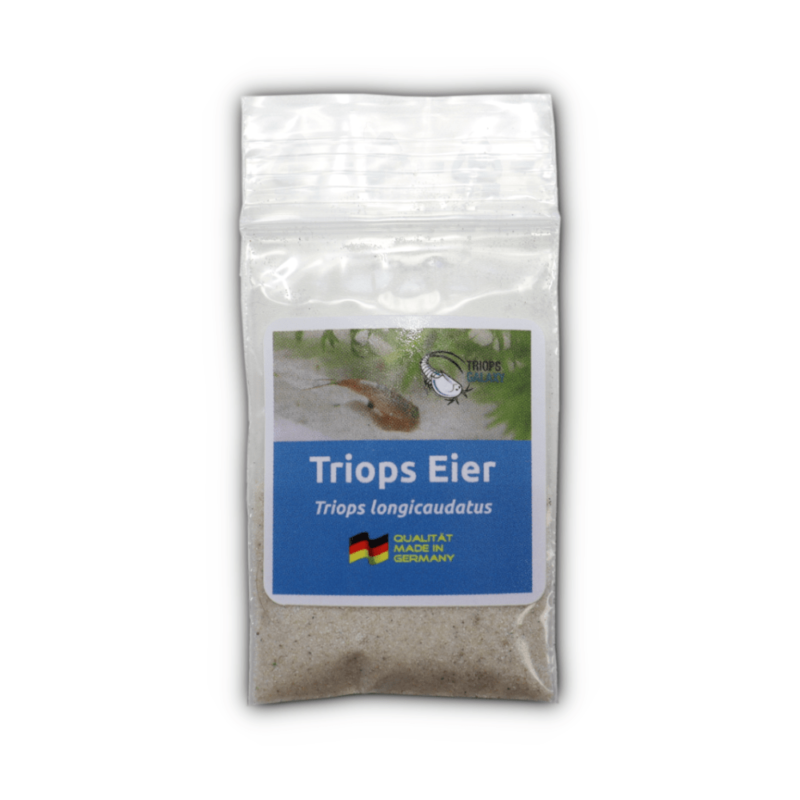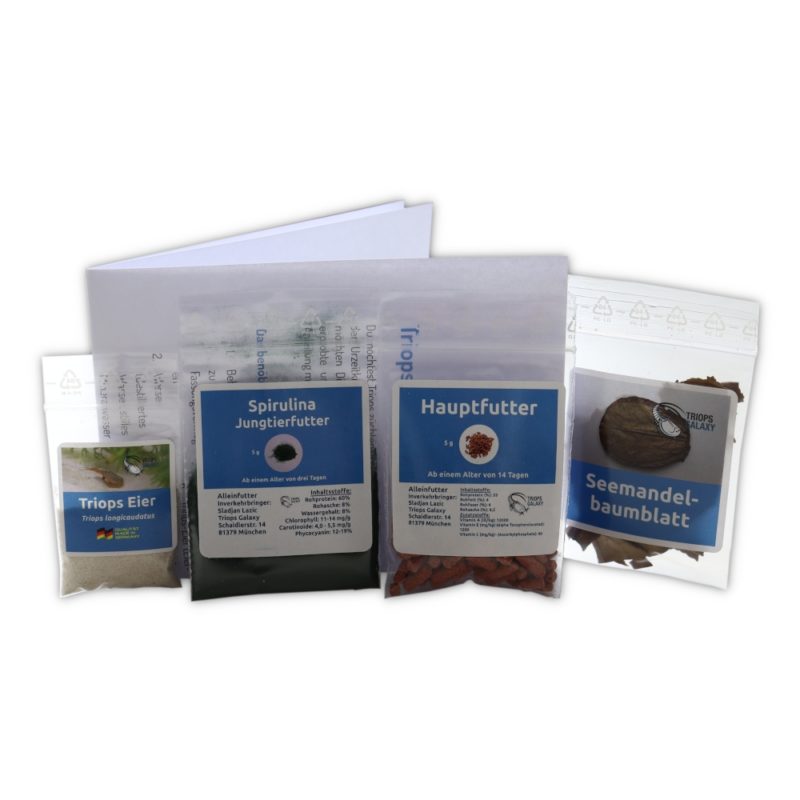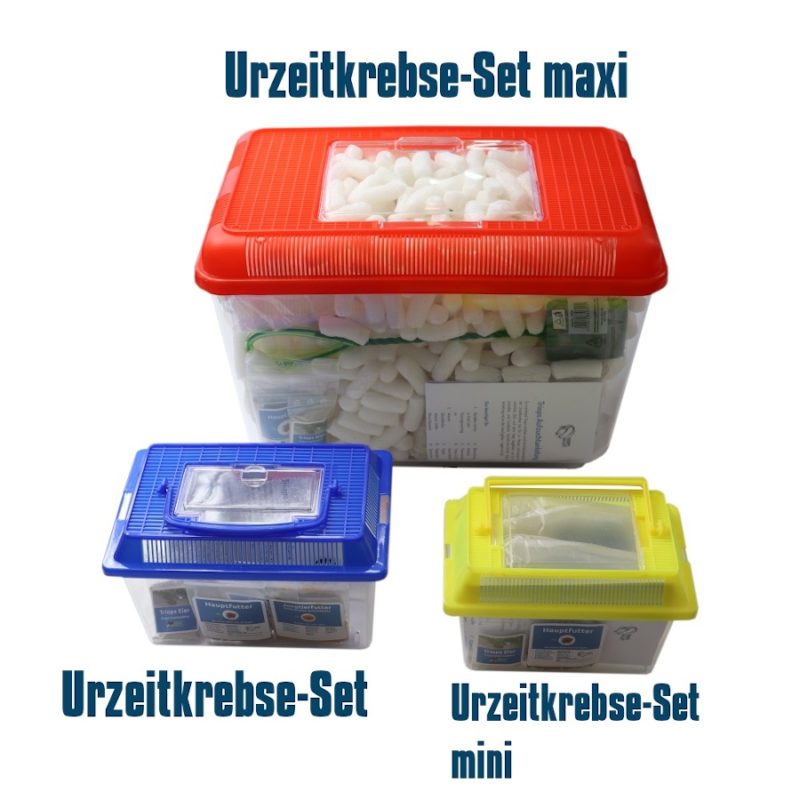Guide
New to Triops breeding? These tips can save you a lot of frustration
Hello and welcome to Triops Galaxy – the world of Triops! It’s great that you are interested in breeding Triops and prehistoric crustaceans and that you want to dive into the fascinating prehistoric world. Perhaps you have already made up your mind and would like more detailed information before buying. Then you are in the right place. This page is intended for interested hobby biologists and beginners in Triops breeding. The aim is to make it as easy as possible for you to start breeding and to help you choose the right starter pack or set. You will also learn about the most common mistakes and misunderstandings in Triops breeding and how to avoid them. I’d say let’s get started!

Breeding triops is not difficult, but …
Breeding Triops is not difficult in principle. All you need is a container, distilled water, still mineral water and a breeding mixture with Triops eggs. Fill the container with water (70 per cent distilled water and 30 per cent still mineral water), tip the mixture into the water and wait about 24 hours for the first nauplii to hatch. That’s it. Breeding can be successful in this way and often it is. Of course, it is not the best way and often enough the hatching does not happen.
Often you can read in forums and comments here that nothing hatches from the nuclei and the nauplii die after a few days. Both the failure to hatch and the death of the nauplii have natural causes that breeders can hardly influence.
Even if you as a breeder follow the instructions one hundred percent and do everything excellently, it does not mean that everything will work and Triops will hatch. External influences such as thunderstorms and air pressure can ruin a breeding.
Nevertheless, one should not give up, but dry the egg-sand mixture and start again under different conditions. However, there are measures that can favour hatching and prevent the death of the nauplii. I will go into these measures in more detail below.
As a beginner, I would like to advise you to inform yourself thoroughly and read up on the subject before buying and breeding for the first time. Here at Triops Galaxy I have built up a comprehensive guide that answers most of the important questions about Triops breeding. The YouTube channel also has numerous videos to help you get started. Breeding Triops is not difficult, but it does require some basic knowledge. Only if you have the necessary basic knowledge will you save yourself the disappointment of a failed breeding.
→ More information about Triops breeding errors can be found in the main article: The 5 biggest mistakes in Triops breeding
In the following I will go through the most important points in Triops breeding point by point.
1. Nature’s conservation – Not every egg hatches
A common reason why no nauplii hatch from the breeding stock is due to nature’s preservation of the species. Nature has developed an ingenious survival strategy for our Triops. In the wild, Triops live in puddles and pools of water created by seasonal flooding. Before the waters dry up, the permanent eggs are laid by the females. Renewed contact with water triggers a hatching impulse, which activates the eggs.
But here it should be noted that not all eggs are activated. Only about every fourth egg hatches into a nauplius.
This strategy of nature ensures that other eggs only hatch in many years and even decades. If all the eggs were to hatch at the same time, the Triops would not be able to survive for many millions of years.
→ More information can be found in the main article: Breeding Triops
2. No light, no hatching
If breeders do not use lighting, breeding is doomed to failure from the start. Only light triggers the hatching stimulus, so light is essential. The light can also be used as a heat source, but in winter the lamp should not be used as a substitute for a heating rod. If the LED lamp is switched off at night, there will be a sharp drop in temperature and the water will no longer be at the required temperature. In the worst case, the Triops could die. LED aquarium lamps provide good lighting conditions because they usually have a day and night mode. However, this is not absolutely necessary. Triops need at least twelve to a maximum of 14 hours of light daily.
3. The right water and the right temperature
Just like light, the use of the right water is essential in Triops breeding. But which water is the best? You can use river water as well as water from a lake, a stream or a pond. These contain many nutrients and minerals. It is important that the water is not polluted. In the breeding here at Triops Galaxy, the mixture of 70 percent distilled water and 30 percent still mineral water has proven successful. I achieve excellent hatching results with this.
Besides the water, the water temperature is crucial. If the water is too cold or too warm, the nauplii will not hatch. In winter, a heating rod should always be used to ensure a constant water temperature. In summer, on the other hand, no additional heating of the tank is needed. The species Triops longicaudatus needs a temperature between 24 and 28°C, while other species like Triops australiensis thrive best at a water temperature between 27 and 31°C.
→ More information can be found in the main article: The right water and optimal water values
4. Sea almond leaves increase the probability of hatching
The leaves of the sea almond tree (Terminalia catappa) have proven their worth as a preventative against fish diseases in aquaristics. They have a fungicidal (“fungus-killing”) and disinfecting effect. The plant contains substances that are beneficial for water quality, such as humic acids, triterpinoids and flavonoids, which dissolve in the water and act against harmful bacteria. Sea almond leaves strengthen the immune system of the fish and allow the aquatic inhabitants to recover more quickly from inflammations and fin rot. Practice has shown that Triops hatch more frequently when sea almond leaves are used than when reared without this plant.
→ More information can be found in the main article: Why this plant is indispensable for your cultivation
5. Feeding – Please do not overfeed Triops!
As a beginner in Triops breeding, you will automatically tend to provide the Triops with as much food as possible. After all, you don’t want the little creatures to starve. Unfortunately, the consequence is that the Triops often die if they are fed too much. You mean well, but unknowingly cause the opposite. When there is an excess of food, the food remains on the aquarium floor and decays. Dangerous substances such as nitrite and nitrate are released and rapidly deteriorate the water quality. Within hours, the Triops can die. Here is a clear rule: Please, do not overfeed your Triops! Your Triops are more likely to die from too much food than too little. They can even survive a whole day without food.
→ More information can be found in the main article: Feeding triops
Starter pack or primeval crab set? Which product should I buy as a beginner?
As a beginner, you might browse around the online shop a bit perplexed and not know right away which product you should finally start your Triops breeding with. This is where I would like to remedy the situation. Here at Triops Galaxy I have put together different product variations. There are individual breeding kits, i.e. sachets with the egg-sand mixture. These are offered in variations with at least 50, 150 or 300 eggs. The breeding kits are suitable for breeders who already have food and a tank as well as other accessories.
We continue with the three starter packs, which in turn contain a mini and a maxi variation. The starter packs come with food, depending on your needs. The maxi starter pack contains a sachet of chopped almond leaves. The starter packs are intended for beginners who have a tank and other accessories, but no Triops eggs and no food.
Last but not least, there are the three primeval crab sets. These also have a mini and a maxi variation. These sets are aimed at buyers who need much more equipment and do not have a tank or sand, for example.

🏅 Triops longicaudatus – Primeval crab eggs, egg-sand mixture 🦐
In stock
VAT exempt according to §19 UStG.
plus Shipping costs
Delivery time: Approx. 2 to 3 working days.

🏅 Triops longicaudatus – primeval crabs starter pack 🦐
In stock
VAT exempt according to §19 UStG.
plus Shipping costs
Delivery time: Approx. 2 to 3 working days.
The selection at Triops Galaxy leaves nothing to be desired and enables all budding breeders to find the right product for them individually and breed the fascinating Triops at home in just a few days and experience primeval times.
Thank you for your attention!
I am pleased that you have read through this beginner’s guide to the end and thank you for your attention! Some things may seem inconclusive to you at this moment, but we are still in pure theory here. The learning and experience values begin with the practical breeding and then the theory will complement the practice.
When the first nauplii have hatched in the tank, you will feel transported to the time when dinosaurs ruled our planet. The feeling of hosting a piece of prehistory in your living room right now is simply fantastic. Let’s go on a journey to the prehistoric times!
Following this introduction, I recommend you visit the Triops Galaxy guide. There you will find a lot of articles with useful information. I wish you much success with your own Triops breeding!
- Vietnam: Hundreds of thousands of fish die due to drought and heat - 3. May 2024
- Introduction to the basics of ichthyology - 28. April 2024
- Palaeontology: Fossil traces from China point to raptors - 27. April 2024
